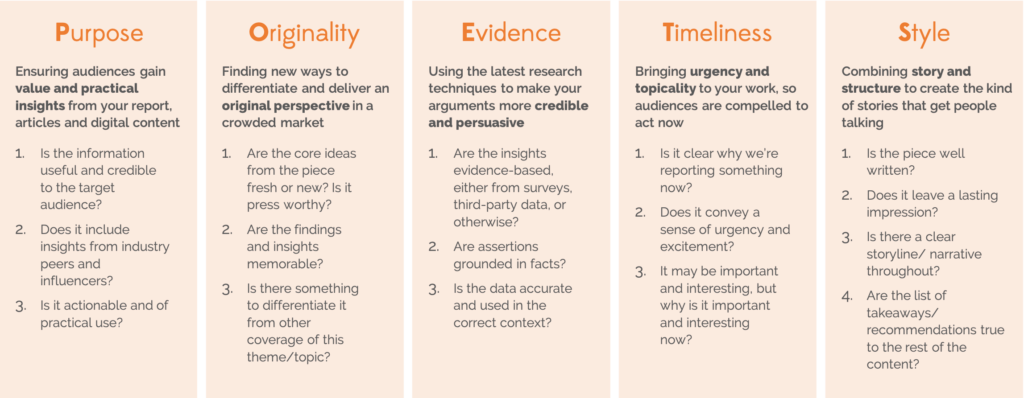ROQ: What’s your return on quality?
Rob Mitchell
In most areas of our daily lives, we understand the relationship between quality and value. It makes perfect sense that a Ferrari costs more than a Ford, because it’s quite clear that the former has better performance, more expensive components and requires more labour to build than the latter.
Yet, in B2B and thought leadership content, the relationship between quality and value is less well understood.
High performance on the widely recognised metrics of success – such as traffic, click-through and bounce rates – can be easily enhanced by wily digital marketers. (For example, web traffic can be increased through paid search or social and click-through rates can be boosted by catchy headlines – even when the underlying quality of the content is not particularly high.)
As a result, some marketers become tempted to take short-cuts on quality. Why spend time and resources creating evidence-based, well-researched content if you can get the performance you need through clever digital marketing techniques?
At FT Longitude, we believe that investment in high-quality content is vital for long-term, sustainable success. Digital marketing techniques may drive short-term gains, but they rarely deliver on longer-term performance – how can they yield any real commercial and brand benefits if the underlying quality of the content is not there? Audiences are too discerning for that.
How do you measure quality?
To gain a better understanding of the link between the quality of content and value, we first need to establish what we mean by quality in this context. At FT Longitude, we use a framework called POETS to evaluate editorial quality; this stands for Purpose, Originality, Evidence-based, Timeliness, Style.
We would regard content that scores strongly on all these dimensions as high-quality from an editorial perspective.
There are other factors that need to be considered besides editorial quality. Design is vital – is the content visually engaging and memorable? Experience is also key – is it accessible and does it offer the reader need the right level of insight at the right time?
Our Learning from Leaders report highlights this, with research showing that brands must think about how different types of content affect buyers at all the stages in the decision-making journey.
Pay for quality, not length
Of course, quality can be expensive. Producing content that scores highly across all dimensions of POETS demands investment, and setting that investment at the right level can be difficult. Investing in quality is critical, but there can come a point when the level of that investment is too high – and starts to yield diminishing returns.
The problem is that it’s traditionally been very difficult to measure return on investment (ROI) in quality. In the absence of a clear framework, quality comes to be seen as a cost to be managed by trimming investment in research and content creation. Companies end up producing content that is ‘good enough’ or that fills a gap. Quantity becomes prized over quality and the end result does not always meet the ultimate goals of influencing audience behaviour and driving commercial outcomes.
Our view is that quality content needs to be seen as an investment with a tangible return. Yes, it’s more expensive to produce, but quality has a valuable premium that will usually deliver outsized returns for your content marketing campaign.
So, how should companies go about measuring the ROI on content quality?
Implementing a framework for editorial quality
To do so requires a focus on both inputs and outputs. A framework like POETS helps to set a bar for the input of editorial quality. The goal is to produce content that readers are likely to find engaging and valuable, based on a number of underlying metrics that are both consistent and repeatable.
But POETS, valuable as it is, is just one part of the equation. To determine if that investment in quality is really paying off, it’s vital to look at the outputs, too.
This is where we return to content marketing metrics – but with an emphasis on those that assess whether audiences are truly engaging with our content, not just being seduced by catchy headlines or surrendering to bombardment by paid search and social. Key metrics to focus on include dwell time, social media engagement, conversion rates, SEO ranking and page authority.
By measuring both the quality of the input, and the impact of the output, we start to see whether there is evidence of a link between higher-quality content and better outcomes. Does content that scores highly on a framework like POETS also yield higher dwell time and social sharing, for example? In our experience, that link will almost always be there, but it’s important for marketers to carry out these tests for themselves.
Demonstrating value
This measurement and validation process is important, not only to demonstrate the benefits of investing in quality content, but also to justify it to key stakeholders.
Consider the following two campaign examples. In one, the marketing team is under pressure to deliver content to a tight budget. They decide not to invest in proper research to provide a foundation of evidence, and assign a fairly junior team to create the content. In the second campaign, the marketing team is under less budgetary pressure. They carry out primary research and allocate considerable internal and external resources to ensure that the content is as original and insightful as possible. Although both campaigns generate the same volume of content, the second one costs three times as much as the first. So, which one offers better value for money?
The answer, of course, depends on how you measure the results. It is possible to achieve good marketing outcomes at relatively low cost, and there’s also no guarantee that spending more leads to better outcomes. But, by building a better understanding of the relationship between investment in quality and the return it generates, companies can start to conduct more rigorous and effective planning processes. They will be able to justify investments more easily and have a much clearer picture of how much they should be spending to ensure both quality and commercial gains.
One thing is for sure: successful content that influences and changes behaviour takes effort and that requires investment. The reality is that, in more than any other area, marketing and content teams fall down in their understanding of the link between investment in quality and the return on that investment.
Our advice is simple:
- Focus on quality not quantity – develop content that provides real value for audiences, not that which merely checks the most boxes in your activation plan.
- Identify and implement a quality-checking process, or quality framework, to which all teams can adhere.
- Measure the metrics that matter, such as dwell time, social media engagement, conversion rates, SEO ranking and page authority.
- Demonstrate the value – play back your findings to your teams and stakeholders. Ensure the business, and your partners, understand the benefits and recognise the returns.
To find out how you can improve the quality and impact of your content and thought leadership campaigns, why not consider a content audit carried out by the experts?
Speak to the team
We’ll help you to navigate and overcome any challenges you currently face and learn how to get more out of your content.
Book a meeting
About the author: Rob Mitchell
Rob is our CEO and co-founder and leads FT Longitude’s strategic planning and sets the overall vision and priorities for the business. He manages the board-level relationship with FT Longitude’s parent company, the Financial Times group, and also oversees FT Longitude’s finances, people management and administration.
Prior to co-founding FT Longitude in 2011, Rob was an independent writer and editor. Between 2007 and 2010, he was a managing editor at the Economist Intelligence Unit and prior to that he was an editor at the Financial Times, where he was responsible for the newspaper’s sponsored reports, including the Mastering Management series.
 |
Tel:
+44 (0)20 7873 4770
|
Tel:
+44 (0)20 7873 4770



